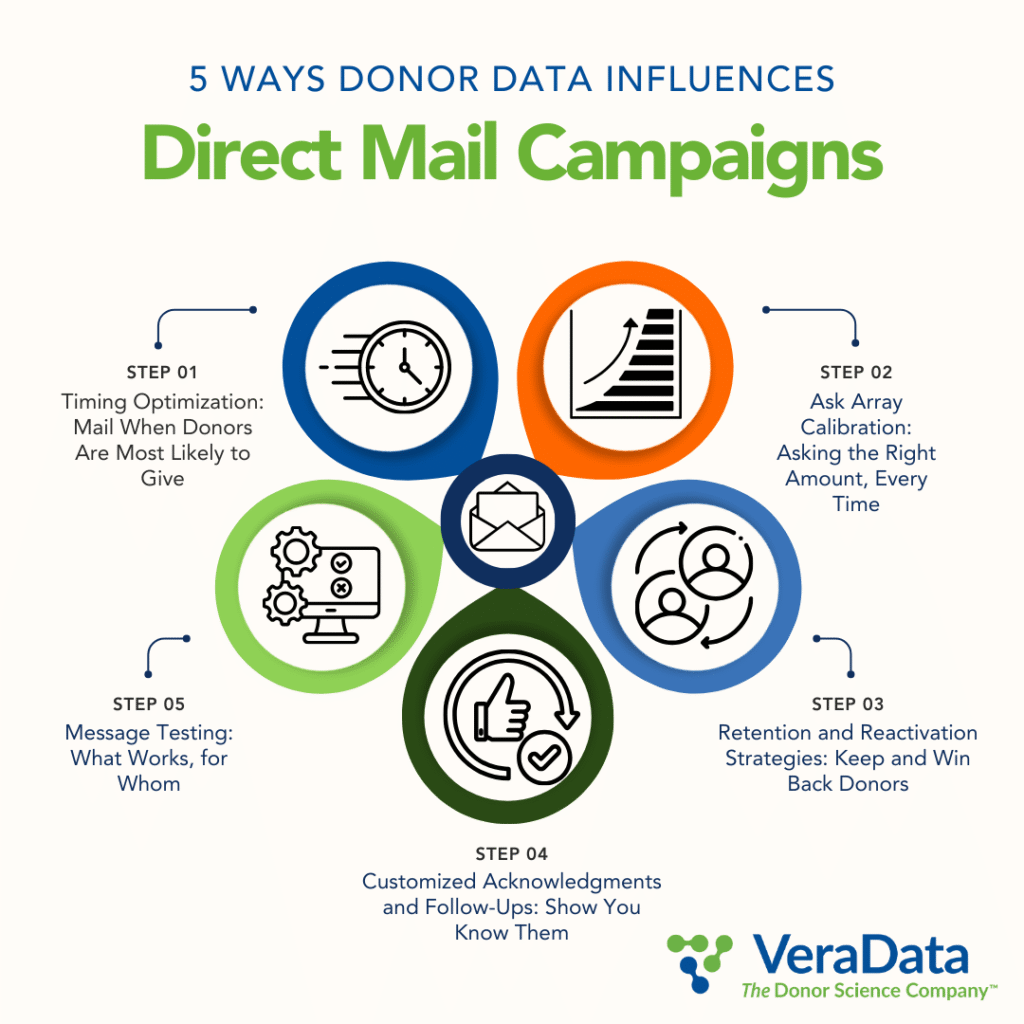News & Info
5 Ways Donor Data Influences Direct Mail Campaigns
09/08/2025
Direct mail still moves donors. It’s tactile, trusted, and proven—especially when the message feels like it was written for the reader. The problem? Too many appeals look the same to every household. When everyone gets the identical letter, response and revenue suffer.
The fix? A data-informed strategy powered by AI and Donor Science™. With predictive modeling and behavioral insight, you can sharpen targeting, calibrate the ask, and speak to donors in ways that actually fit their habits and motivations. It’s time to rethink how you plan, write, and mail—starting with the five levers below.
1. Timing Optimization: Mail When Donors Are Most Likely to Give
The right message can fall flat if it arrives at the wrong time. Every donor has their own “giving window,” driven by habits, history, and timing preferences. Rather than relying purely on general patterns like month-of-year tendencies, event cycles, and end-of-year giving, AI-powered analytics can uncover individual timing trends, such as donors who prefer spring campaigns or those who respond during specific annual matching challenges.
By analyzing past donation dates and response rates, you can pinpoint when each donor is most likely to give.
2. Ask Array Calibration: Asking the Right Amount, Every Time
Ever struggled with how much to ask for in a direct mail appeal? Too small of an ask leaves revenue on the table, while an ask that’s too large can alienate a potential donor. This is where the power of an ask array comes in. It matters because it anchors the donor’s choice.
Donor Science™ flips guesswork into strategy by examining a donor’s past gift amounts, frequency, giving trajectory, upgrade velocity, and response to matches to suggest the right range. AI can generate donor-specific gift tiers that scale to meet each donor where they are. The result? Confidence-boosting gift tiers that drive higher average donations without overstepping.
3. Retention and Reactivation Strategies: Keep and Win Back Donors
Retention matters. And so does reactivation. Your donor data holds the key to prioritizing both.
Use your file to spot two critical groups:
- Loyal donors who deserve stewardship touches, impact updates, and soft asks.
- Lapsed donors who need a clear and compelling reason to return.
Build segments accordingly: VIP stewardship letters with previews of upcoming initiatives; reactivation packages that acknowledge time away, reduce giving friction with simplified reply devices, and offer a timely match. Right segment, right tone, better long-term value. Donor Science™ models estimate attrition risk and the likelihood of re-engagement.
4. Customized Acknowledgments and Follow-Ups: Show You Know Them
When was the last time you received a thank you message that felt personal? A fast, thoughtful thank you sets the stage for the next gift. Reference what’s true for that donor—last gift date, amount, event attendance, or an action they took beyond giving. Tailored acknowledgments reaffirm to donors that they’re more than an ID number in your database—they’re partners in your mission.
These small but meaningful actions build lasting trust and generosity.
5. Message Testing: What Works, for Whom
Direct mail isn’t an exact science—it’s an evolving strategy. A/B testing allows you to experiment with variables. Try variations in outer-envelope teaser, headline, letter signer, premium, and call-to-action. Different segments react to different messages: urgency language for late responders, impact storytelling for mission-driven supporters, match framing for higher-capacity households.
Use Donor Science™ to read the results quickly and roll winners forward. Remember, even small tweaks—like a revised headline or a clearer reply device—can deliver a better result.

Direct Mail Powered by AI and Donor Science™ Delivers
Properly used, AI and Donor Science™ can take your direct mail to another level. Rather than sending generic mass mail, you can connect with donors in ways that differentiate your organization and make a personal connection. You can fine-tune timing, individualize messaging and ask strategies, and otherwise customize each supporter’s communications experience to unlock deeper relationships and boost retention rates. A well-executed mail program can make your donors feel more connected to your mission—and raise more money for your good work—than ever before.